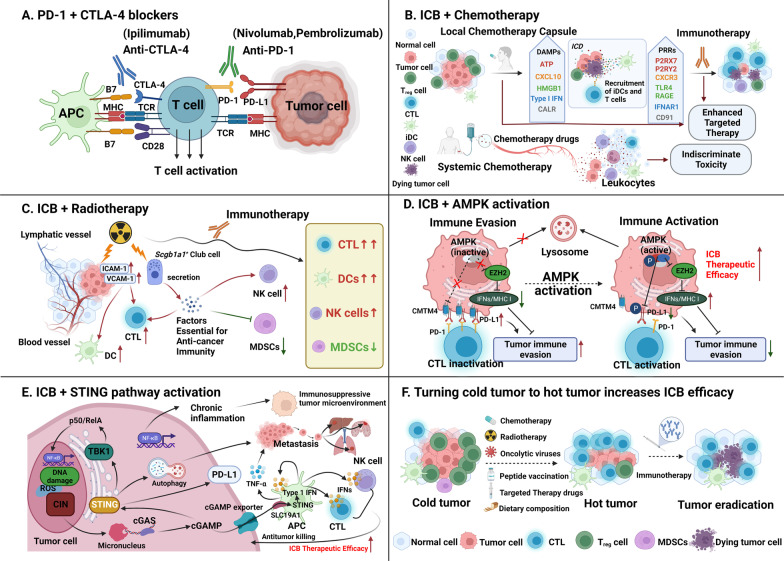Fig. 2.
Combination strategies to enhance the therapeutic efficacy of PD-1/PD-L1 blockade. A Combination therapy with PD-1 and CTLA-4 blockers. The activation of PD-1/PD-L1 and CTLA-4 can be blocked by anti-PD-1/PD-L1 and CTLA-4 antibodies, respectively. The combined application of PD-1 and CTLA-4 inhibitors produces synergistic effects. B Combination therapy with chemotherapy. Chemotherapy is able to induce ICD, promote the release of tumor antigens and DAMPs, activate DCs, induce local production of CXCL10, recruit T cells to the tumor bed and enhance the differentiation of antitumor-specific CTLs. Chemotherapy can also reduce the number of immunosuppressive cells, such as MDSCs and Tregs. However, systemic chemotherapy shows undifferentiated toxicity to tumor cells and the anticancer immune system, while local chemotherapy enhances immunotherapy by remodeling the TME and attracting activated immune cells to the tumor region. C Combination therapy with radiotherapy. Radiotherapy markedly upregulates the cell adhesion factors ICAM-1 and VCAM-1 on the surface of cancer cells. One of the mechanisms by which radiotherapy may enhance immunotherapy is through activation of certain types of club cells which release proteins that are beneficial to immunotherapy. D Combination therapy with an AMPK activator. Reduced PD-L1 levels in the presence of AMPK activation could enhance the efficacy of combining ICB with an AMPK activator. E Combination therapy with STING agonists. The cGAS-STING pathway is essential for linking the innate immunity and adaptive immunity against cancers. Cancer cells can escape immune surveillance by inactivating the cGAS-STING pathway. Therefore, ICB can be combined with STING agonists to boost the efficacy of immunotherapy. F “Cold” tumors lack activated tumor-specific T cells, which may contribute to primary resistance to ICBs. Effective combination therapy can turn these tumors into hot tumors that are sensitive to ICBs

